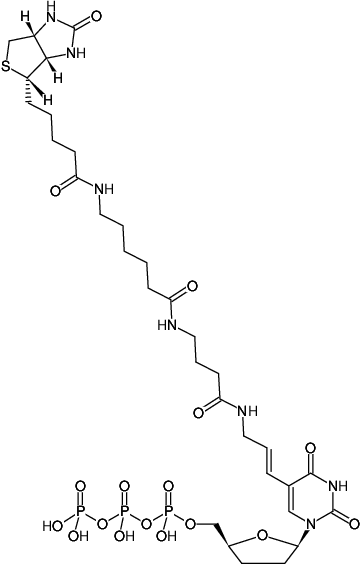Biotin-16-ddUTP
Biotin-16-(5-aminoallyl)-ddUTP
Biotinyl-ε-aminocaproyl-γ-aminobutyryl-5-(3-aminoallyl)-2',3'-dideoxyuridine-5'-triphosphate, Triethylammonium salt
| Catálogo Nº | Apresentação | Preço (R$) | Comprar |
|---|---|---|---|
| NU-253-BIO16-S | 25 μl (1 mM) | Sob demanda | Adicionar ao Carrinho |
| NU-253-BIO16-L | 5 x 25 μl (1 mM) | Sob demanda | Adicionar ao Carrinho |

For general laboratory use.
Envio: shipped on gel packs
Condições de armazenamento: store at -20 °C
Short term exposure (up to 1 week cumulative) to ambient temperature possible.
Validade: 12 months after date of delivery
Fórmula molecular: C32H52N7O17P3S (free acid)
Peso molecular: 931.78 g/mol (free acid)
CAS#: 188755-42-2 (Tetralithium salt), 748750-05-2 (free acid)
Pureza: ≥ 95 % (HPLC)
Forma: filtered solution (30 kDa) in 10 mM Tris-HCl
Concentração: 1.0 mM - 1.1 mM
pH: 7.5 ±0.5
Propriedades espectroscópicas: λmax 240/289 nm, ε 10.7/7.1 L mmol-1 cm-1 (Tris-HCl pH 7.5)
Formulários:
- Technique for nanoscale patterning of functional molecules on the surface of a DNA origami[1]
- 3'-end labeling of oligonucleotides with Terminal Transferase, recombinant and labeling DNA[2,3]
- MALDI-TOF MS-based SNP typing assay[4]
- Biotinylation of in vitro transcribed tmRNA during surface plasmon resonance (SPR) technique[5]
- Use in the standard nick translation reaction for tumor DNA labelling during comparative genomic hybridization[6]
Referências selecionadas:
[1] Jahn et al. (2011) Functional patterning of DNA origami by parallel enzymatic modification. Bioconjugate Chem. 22:819.
[2] van de Vliet et al. (2009) Highly polymorphic microsatellite markers for the short-snouted seahorse (Hippocampus hippocampus), including markers from a closely related species the long-snouted seahorse (Hippocampus guttulatus). Conservation Genet. Resour. 1 (1):93.
[3] Tengs et al. (2007) Microarray-based method for detection of unknown genetic modifications. BMC Biotechnology 7 (1):91.
[4] Mengel-Jørgensen et al. (2005) Typing of multiple single-nucleotide polymorphisms using ribonuclease cleavage of DNA/RNA chimeric single-base extension primers and detection by MALDI-TOF mass spectrometry. Anal. Chem. 77 (16):5229.
[5] Okada et al. (2004) Contribution of the second OB fold of ribosomal protein S1 from Escherichia coli to the recognition of TmRNA. Biosci. Biotechnol. Biochem. 68 (11):2319.
[6] Liebisch et al. (2003) Value of comparative genomic hybridization and fluorescence in situ hybridization for molecular diagnostics in multiple myeloma. British Journal of Haematology 122:193.
